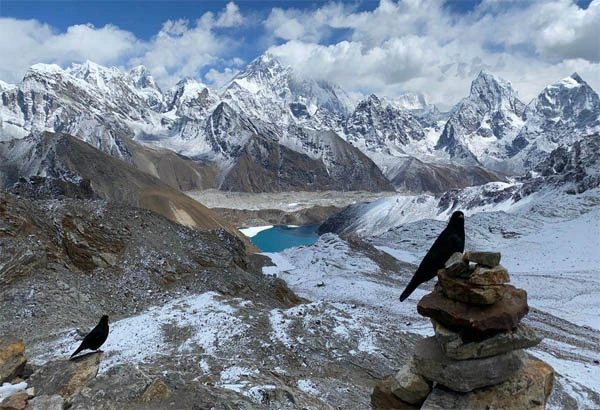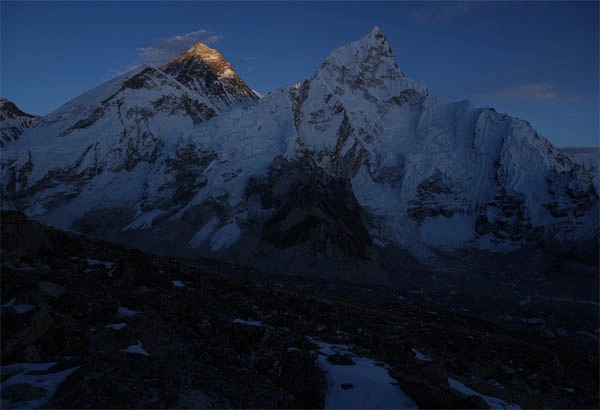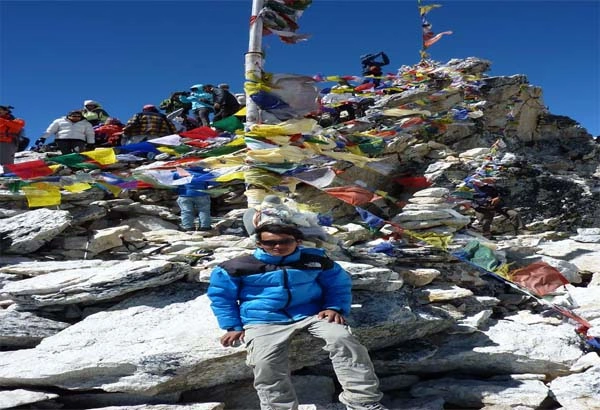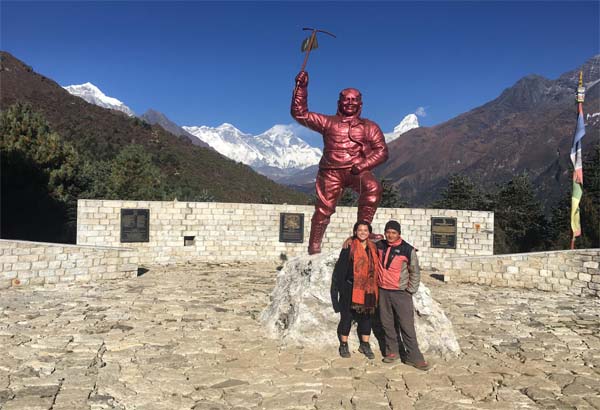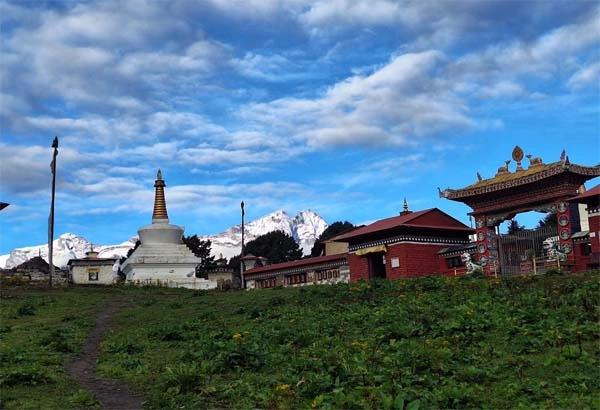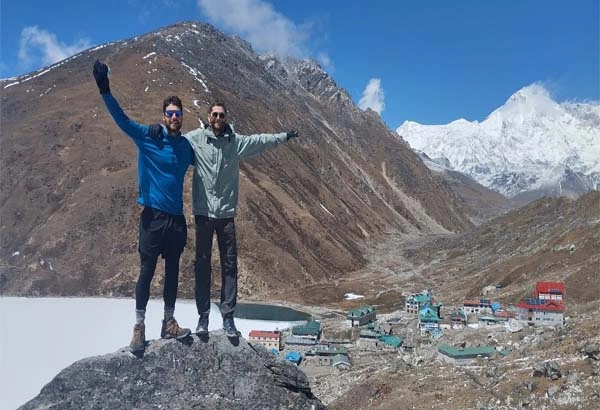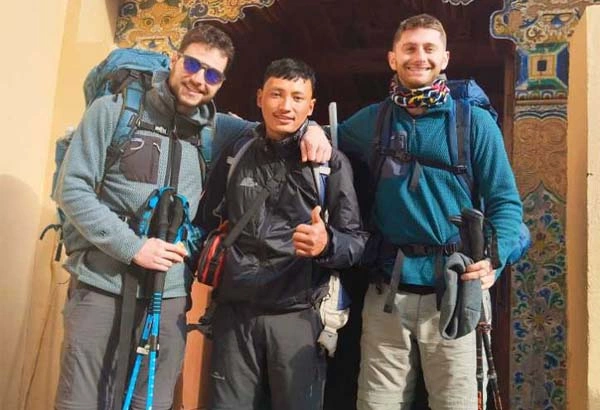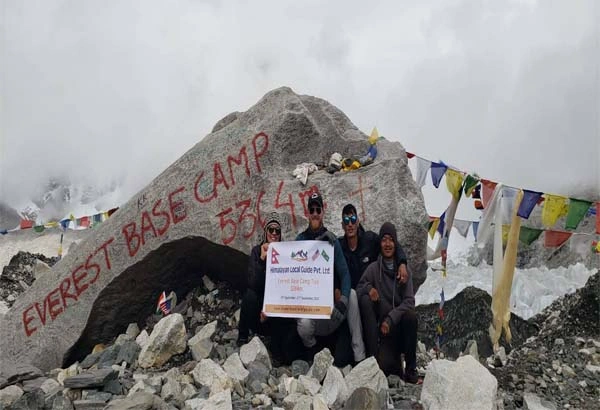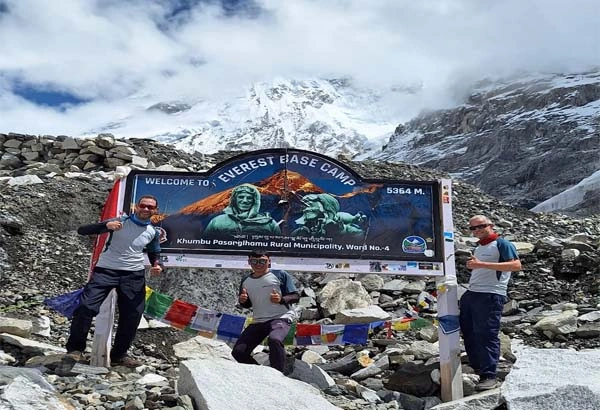Trip Highlights
- Beautiful flight from Kathmandu to Lukla.
- Local Sherpa culture and lifestyles.
- Old Sherpa Museum and Sonam Photo Gallery at Namche Bazaar.
- Pass the beautiful Villages of Phakding, Nache Bazzar, Tengbuche, Dingbuche, Labuche, and Gorakshep.
- More than 8 thousand mountains like makalu(8467m), Lhoste (8535m) and choyu(8185m) .
- World's highest airport in Syangbuche.
- Stunning views from Everest View Hotel.
- Amazing the world's highest peak of Mount. Everest (8,848m).
- Delightful Khumbu Glacier.
- Wild a range of flora and fauna.
- The Ancients Buddhist Monastery in Tengbuche and Pangbuche.
- Sir Edmund Hillary school (khumjung village).
- Visit to Everest Base camp (5,306m).
- Sunrise and Sunset view from Kala Pathar (5,545m)
Detail About Solo Everest Base Camp Trek
A Solo Everest Base Camp trek is completely possible. If you are thinking about; a travel of a lifetime experience and Contemplating the travel planner to join, no worries about this outing being achievable all alone. The Journey to Everest Base Camp is the most well-known traveling destination in the Nepal Himalayas Region.
The astonishing journey to Everest Base Camp is among the most outstanding and charming in the Sagarmatha National Park region. This journey gives a wide assortment of landscapes, nature, and culture; that are exciting.
Solo Everest Base Camp Trek
Many trekkers want to do a solo trek in the Everest region trek. It is possible to go to the Everest Base camp trek by a single person. Do not worry, whether the person is male or female. It is 99% safe and also more thrilling. Himalayan Local Guide Pvt. Ltd has been organizing the Everest Base Camp trek solo for a decade. For every solo traveler, we manage the expert guide and porter at the demand of the solo trekker.
Though the trek can be done the whole year and in any season. However, the period between autumn and spring is the best time for the Everest Base Camp trek solo.
Why is a trekking guide required for the Everest Base Camp trek?
The EBC trek without a guide will be rather risky and uncomfortable. While trekking in the Everest region, the solo trekker will find it difficult to find the right trekking trail since there are side paths used by local people. If you take a guide, there will not be any confusion in finding the trekking route. Through the guide, you will get important information about the mountain regions, villages, Sherpa's lifestyle, flora, and fauna.
An additional more important thing is that EBC is a high-elevation trip. The trekker needs to walk from 2800 meters up to 5545. So, Highland sometimes you might face high altitude sickness. High altitude sickness must be properly held on time. In case, you need to immediately evacuate by chopper to Kathmandu, However, in such an emergency, if you have a guide, he will help everything well, and you will feel safe.
Is EBC Solo Trek Difficulty?
The brilliant excursion to Everest Base Camp is a technically challenging trek in the Everest region. You need to ascend and descend to higher elevations. Be that as it may, it's fascinating making and achieving your dream goal of a lifetime; this excursion likewise brings a lot of happiness with various encounters of a genuine of the Himalayas people groups and local hospitality. These trips are not only about; climbing up and down but also about achieving an immense equal experience that can change your life.
The Independent EBC trek design takes you the entire way to Everest. It is the highest point of the world's most remarkable mountain. It's situated at an altitude of (5,364m/17,598ft) through the Wonderful Khumbu locale into the Sagarmatha National Park. Also, this 9-day Everest Base camp journey route likewise includes; Kala Patthar (5,545m/18,192ft) one of the most magnificent perspective points for sunrise and sunset with delightful, scenic views of the whole Everest region.
EBC trek Route
The Everest Base Camp Trek beginnings from Lukla with a short flight from the capital city of Kathmandu, Nepal. A leading trekking guide by our responsive and hospitable Sherpas, Rais. The main traveler/trekkers junction is Lukla takes; us through the most pleasing; and historical Sherpa villages; Phakding, Monju, Jorsalle, Namche Bazaar, Tengboche, Pangboche, Dingboche, Labuche, and Gorakshep. Then after reaching them at your final destination at EBC, journey downhill to Tengboche, Namche, Lukla, and a trip back to Kathmandu.
The EBC trekking Itinerary is designed by our expert trekking guide team; for those mountaineers, who are planning to participate; in Everest for a limited time; our time is always in the mountains with mountain lovers and hikers. Then, you may keep contacting; us by email: info@himalayanlocalguide.com WhatApps: +977-9818141334.
Trip Itinerary Expand All
- Walking Distance 6.2km/3.8 Miles
- Maximum Height 2610 Meters
- Accommodation Hotel/Lodge/Tea House
Early morning flight to Lukla (2860m/9,383feet) which is takes around 30 minute fly form Kathmandu to Lukla is main junctions of trekker’s where we meet the rest of our team in Lukla and start our trekking form there. We walk along the on the way passes through the delightful village of Cheplung village, Ghat and Phading Village (2640m/8,661feet). Overnight at Lodge.
- Day Meals Breakfast/Lunch & Dinner
- Walking Distance 7.4Km/4.6 Miles
- Maximum Height 3445 Meters
- Accommodation Hotel/Lodge/Tea House
After the breakfast, we start our trek passes through delightful pine forest and we trek continue walk on the trail goes to north up the Benkar. We cross the suspension bridge and pass Chumoa and Monjo village before reaching the entrance of the sagarmatha National Park. After then us crossing a suspension bridge again we pass the Jorsale village and walk along side of the Dudh Koshi and Bhote Koshi Rivers. We ascend on a steep trail and reach to Namche Bazzar (3445m/11,302feet). This is most likely the biggest town in the Khumbu region. Overnight at Lodge.
- Day Meals Breakfast/Lunch & Dinner
- Maximum Height 3445 Meters
- Accommodation Hotel/Lodge/Tea House
After the breakfast, we hike to Everest View Hotel, first part we ascend on a steep trail and reach to Everest Hotel, from there if the blue sky we will be able to see the delightful mountains views of Mt. Everest, Nuptse, Lhoste, Ama Dablam, Thamserku, Kusumkangaru and many more mountains view etc. then after we go to explore the Khumjung Village, this village one of the beautiful colorful rooftop houses and we explore the sir Edmund Hillary school, while finished it we back down to Namche Bazzar and Overnight at Lode.
- Day Meals Breakfast/Lunch & Dinner
- Walking Distance 9.2Km/5.7 Miles
- Maximum Height 3870 Meters
- Accommodation Hotel/Lodge/Tea House
From Namche Bazzae, we ascend on steep trail after then, the trek until phunki is an easy walk. From there we ascend towards tengboche village, which is one of the famous Tengboche monasteries because of the biggest monastery of the Khumbu region. It is located within the sagarmatha National park, which is a UNESCO world Heritage Site. The beautiful Monastery with an amazing panoramic view of the mountains including; Mt. Everest, Lhotse, Ama Dablam, Nuptse and Thamserku. Monastery will be opens around at 4:00 pm; if we reach there on time we can go to see the Buddhist religions ceremony. Overnight at Tengboche.
- Day Meals Breakfast/Lunch & Dinner
- Walking Distance 12Km / 7.45Miles
- Maximum Height 4320 Meters
- Accommodation Hotel/Lodge/Tea House
From the Tengboche Monastery village, our trail descends and passes through lush pine and rhododendron forest, when trekking we can think highly of good views of Top of the world’s highest Mt. Everest, Lhoste and Ama Dablam. We trek continue to Pangbuche, somare and reach to Dingbuche Village. Overnight at Lodge
- Day Meals Breakfast/Lunch & Dinner
- Maximum Height 4320 Meters
- Accommodation Hotel/Lodge/Tea House
After the beautiful breakfast, the second acclimatization day is taking on Dingbuche, beside the acclimatization day we also climb a few hundred meters to the top of Nagarjun which is need to be claimed to check you health conditions and strength before we continue to the EBC. The short acclimatization to Nagarjun it will make very helpful to your physical fitness. It’s quite steep and rocky track but the views becomes much more delightful.
- Day Meals Breakfast/Lunch & Dinner
- Walking Distance 8.5Km / 5.2Miles
- Maximum Height 4910 Meters
- Accommodation Hotel/Lodge/Tea House
After the breakfast, we start our journey. The day with a grdual climb to Thukla then our trail goes to quite steep climb up to the ridge at the top of chukpo Lari where we can find out the line of memorials in tribute to the climbers who have died on Mt. Everest expeditions since starting. After then our trail goes to short gradual up walk brings us to Labuche. Overnight at Lodge.
- Day Meals Breakfast/Lunch & Dinner
- Walking Distance 4 Km/2.4 Miles
- Maximum Height 5185 m
- Accommodation Hotel/Lodge/Tea House
Today is more exciting and hard day. From Labuche the trail leads flat meadow for when following the Khumbu Glacier and shot climbing up. After then the trail goes to into the lateral moraine of khumbu Glacier to Gorakshep. The trail offers a beautiful view of the massive Khumbu Glacier and Trans Himalayas. While we reach to Gorakshep we take off the bag pack at the hotel and we can have some Lunch Break after then we will go to hike the Everest Base Camp. It take around go and back 4/5 Hours and back to Gorakshep overnight at Lodge.
- Day Meals Breakfast/Lunch & Dinner
- Walking Distance 9.6km / 6 Miles
- Maximum Height 4235 Meters
- Accommodation Hotel/Lodge/Tea House
Wake up early morning, after then we hike to kalapathar for sunrise and mountains view. We have to climb up hill it take around 2 hours and if the good weather we will be able to see the beautiful sunrise views with all panoramic Himalayas view from kalapather, when we enjoy with nature then we back down to same hotel we can have breakfast we trek continue to downhill pheriche. Overnight at Lodge.
- Day Meals Breakfast/Lunch & Dinner
- Walking Distance 14.3Km / 8.8Miles
- Maximum Height 3445 Meters
- Accommodation Hotel/Lodge/Tea House
Our trail leads descending passes through the beautiful local sherpa villages and we following the bank into Dudh Kosi River then after Somare, Pangbuche, Dingbuche and reach to Namche Bazzar. Overnight at Lodge
- Day Meals Breakfast/Lunch & Dinner
- Walking Distance 13.5Km/8.38 Miles
- Maximum Height 2860 Meters
- Accommodation Hotel/Lodge/Tea House
The trail descending the steep section back to the same way as we crossed Jorsalle, Manjo, Benkar, Phakding some of the small villages of the way reach to Lukla overnight at Lodge
- Day Meals Breakfast/Lunch & Dinner
Early Morning we will fly back to kathamdnu.
Cost Includes
- International Airport to Hotel and Airport Pick up and drop by private car/van / Jeep / Hiace depending on the Group Size.
- Transportation service from Hotel – Domestic Airport – Hotel by Car.
- Kathmandu - Lukla - Kathmandu flight ticket.
- All meals on a full board basis BLD (Italian, Chinese, Indian, Nepali, and many European delicious food lunches, dinners, and breakfasts) Choose by menu.
- All necessary fees including Sagarmatha National Park Permit and Tims Card (Trekking Information Management System).
- Pasang Lhamu community fee.
- The Himalayan Local Guide team is a Professional Honest, strong, and government-trained English-speaking Guide, His salary, is three times the meals, Insurance, equipment, etc.
- Himalayan experienced strong and honest porters during the trek (2 Clients for 1 Porter).
- Trekking Lodges (Tea House, Guest House, or Home Stay) During the Trek.
- Assistant Guide for the group 5 or above.
- Approval of Certificate after the successful trekking.
- Supplementary energy bars, crackers, Cookies, and Halls, etc.
- Seasonal fruits like; Apple, Oranges, pomegranates Blackberry etc.
- First Aid kit box (Guide will Carry it during the trekking).
Cost Excludes
- Cold drinks, such as beer, mineral water, cock, Fanta, and Whisky etc.
- Coffee & Tea.
- Personal expenses such as laundry, telephone, WIFI, Hot Shower, Shopping etc.
- Your International airfare.
- Nepal visa fee. (15 Days -25 U$D, 30 Days — 40U$D and 90 Days — 100 U$D.
- Hotel in Kathmandu with Lunch and Dinner.
- Trekking Equipments.
- Travel insurance is just in case.
- Tips for Guide and porters.
Departure Date
| Trip Starting Date August 01, 2025 ( 12 Days ) | Price US$ 1320/Per Person | Book Now |
| Trip Starting Date August 04, 2025 ( 12 Days ) | Price US$ 1320/Per Person | Book Now |
| Trip Starting Date August 07, 2025 ( 12 Days ) | Price US$ 1320/Per Person | Book Now |
| Trip Starting Date August 10, 2025 ( 12 Days ) | Price US$ 1320/Per Person | Book Now |
| Trip Starting Date August 13, 2025 ( 12 Days ) | Price US$ 1320/Per Person | Book Now |
| Trip Starting Date August 16, 2025 ( 12 Days ) | Price US$ 1320/Per Person | Book Now |
| Trip Starting Date August 19, 2025 ( 12 Days ) | Price US$ 1320/Per Person | Book Now |
| Trip Starting Date August 22, 2025 ( 12 Days ) | Price US$ 1320/Per Person | Book Now |
| Trip Starting Date August 25, 2025 ( 12 Days ) | Price US$ 1320/Per Person | Book Now |
| Trip Starting Date August 28, 2025 ( 12 Days ) | Price US$ 1320/Per Person | Book Now |
| Trip Starting Date September 01, 2025 ( 12 Days ) | Price US$ 1320/Per Person | Book Now |
| Trip Starting Date September 04, 2025 ( 12 Days ) | Price US$ 1320/Per Person | Book Now |
| Trip Starting Date September 07, 2025 ( 12 Days ) | Price US$ 1320/Per Person | Book Now |
| Trip Starting Date September 10, 2025 ( 12 Days ) | Price US$ 1320/Per Person | Book Now |
| Trip Starting Date September 13, 2025 ( 12 Days ) | Price US$ 1320/Per Person | Book Now |
| Trip Starting Date September 16, 2025 ( 12 Days ) | Price US$ 1320/Per Person | Book Now |
| Trip Starting Date September 19, 2025 ( 12 Days ) | Price US$ 1320/Per Person | Book Now |
| Trip Starting Date September 22, 2025 ( 12 Days ) | Price US$ 1320/Per Person | Book Now |
| Trip Starting Date September 25, 2025 ( 12 Days ) | Price US$ 1320/Per Person | Book Now |
| Trip Starting Date September 28, 2025 ( 12 Days ) | Price US$ 1320/Per Person | Book Now |
| Trip Starting Date October 01, 2025 ( 12 Days ) | Price US$ 1320/Per Person | Book Now |
| Trip Starting Date October 04, 2025 ( 12 Days ) | Price US$ 1320/Per Person | Book Now |
| Trip Starting Date October 07, 2025 ( 12 Days ) | Price US$ 1320/Per Person | Book Now |
| Trip Starting Date October 10, 2025 ( 12 Days ) | Price US$ 1320/Per Person | Book Now |
| Trip Starting Date October 13, 2025 ( 12 Days ) | Price US$ 1320/Per Person | Book Now |
| Trip Starting Date October 16, 2025 ( 12 Days ) | Price US$ 1320/Per Person | Book Now |
| Trip Starting Date October 19, 2025 ( 12 Days ) | Price US$ 1320/Per Person | Book Now |
| Trip Starting Date October 22, 2025 ( 12 Days ) | Price US$ 1320/Per Person | Book Now |
| Trip Starting Date October 25, 2025 ( 12 Days ) | Price US$ 1320/Per Person | Book Now |
| Trip Starting Date October 28, 2025 ( 12 Days ) | Price US$ 1320/Per Person | Book Now |
| Trip Starting Date November 01, 2025 ( 12 Days ) | Price US$ 1320/Per Person | Book Now |
| Trip Starting Date November 04, 2025 ( 12 Days ) | Price US$ 1320/Per Person | Book Now |
| Trip Starting Date November 07, 2025 ( 12 Days ) | Price US$ 1320/Per Person | Book Now |
| Trip Starting Date November 10, 2025 ( 12 Days ) | Price US$ 1320/Per Person | Book Now |
| Trip Starting Date November 13, 2025 ( 12 Days ) | Price US$ 1320/Per Person | Book Now |
| Trip Starting Date November 16, 2025 ( 12 Days ) | Price US$ 1320/Per Person | Book Now |
| Trip Starting Date November 19, 2025 ( 12 Days ) | Price US$ 1320/Per Person | Book Now |
| Trip Starting Date November 22, 2025 ( 12 Days ) | Price US$ 1320/Per Person | Book Now |
| Trip Starting Date November 25, 2025 ( 12 Days ) | Price US$ 1320/Per Person | Book Now |
| Trip Starting Date November 28, 2025 ( 12 Days ) | Price US$ 1320/Per Person | Book Now |
| Trip Starting Date December 01, 2025 ( 12 Days ) | Price US$ 1320/Per Person | Book Now |
| Trip Starting Date December 04, 2025 ( 12 Days ) | Price US$ 1320/Per Person | Book Now |
| Trip Starting Date December 07, 2025 ( 12 Days ) | Price US$ 1320/Per Person | Book Now |
| Trip Starting Date December 10, 2025 ( 12 Days ) | Price US$ 1320/Per Person | Book Now |
| Trip Starting Date December 13, 2025 ( 12 Days ) | Price US$ 1320/Per Person | Book Now |
| Trip Starting Date December 16, 2025 ( 12 Days ) | Price US$ 1320/Per Person | Book Now |
| Trip Starting Date December 19, 2025 ( 12 Days ) | Price US$ 1320/Per Person | Book Now |
| Trip Starting Date December 22, 2025 ( 12 Days ) | Price US$ 1320/Per Person | Book Now |
| Trip Starting Date December 25, 2025 ( 12 Days ) | Price US$ 1320/Per Person | Book Now |
| Trip Starting Date December 28, 2025 ( 12 Days ) | Price US$ 1320/Per Person | Book Now |
Frequently Asked Questions Expand All
The main highest point of this Trek is 5545 meters.
Yes, you can do it privately trek with our local trekking guide and Porters.
The best time to do this trek (September – October – November - December), February – March – April – May).
Pasang Lahmu Community Fee, and Sagarmatha National Park entry fee.
- Do not drink alcohol & smoke
- Walk slowly while you climb uphill
- Take garlic soup and ginger tea
- Drink water 3 to 4 liters per day
- Do acclimatization and rest
- Take a Diamox as per instructors if you have AMS symptoms
Yes, you can change your currency in Nepal; we will help you to exchange your currency
The trekkers need to be paid 13% of the full trip cost in advance and the remaining funds for trekking can be made on arrival in Kathmandu. For the booking of your trek please kindly you may go through the system “BOOKING” form, click on there, and make your reservation.
Yes, you can get the internet; most of the tea house has Wi-Fi.
Yes, you can charge your camera battery and phone; they have electricity and Solar panels.
It is a moderate trek and normally, we have to walk for 9 to 14 days.
Yes, it is safe for solo female travel, our teams are responsible, and they are leading the solo travel through the Nepal Himalayas regions.
No, it is not possible to get an ATM and Bank on the way, so you must take Nepali currency from Kathmandu.
Yes, you need to take a sleeping bag during the trek; it is difficult to get a blanket on the lodges because so many Guides and porters do not have blankets.
Yes, of course, we will provide you professional local trekking guide and porter’s team, who are from the same place or the Himalayas region, our guide has detailed knowledge of the Himalayas, and is a government license holder trained, speaks very well English. Our porters are fully helpful and friendly.
Useful Information
BEST SEASON:
March – April – May (Spring Season)
It is the best time for this Trek. The weather is good throughout the trek. Spectacular views of Mt. Everest, Nuptse, Lhotse, Pumo Ri, Labuche Peak, Island Peak, Ama Dablam, Thamserku, Kusum Khangkaru, Kongde and many smaller white snow-capped mountains etc.
The temperatures will increase from the middle of March and with blue skies, white-snow capped will be seen at their occasion. So many Travelers often succeed their climber in this time. On the way trip, the Nepalese National flowers will be blossom-like; red, white, and pink colors with luscious green and dense forest.
June – July – August (Summer/Monsoon Season)
If you like to between June and August. It is summer/Monsoon Season. Summer Season Falls in the months from the end of June to August. This time is the hottest and rainfalls with a variety of vegetation blossom during this season, the Valley will be green and have a different view than the spring and Autumn seasons. While you are going to travel, Summer Season you have to be more careful with trekking trails, it might be Muddy and Slippery. It will regularly rain and hottest during this season.
The temperature during the days 15 to 25°C, will get colder at night and morning times, Temperature will be less than 8°C, and most of the morning will see blue sky with white snow-capped Mountains.
September – October – November (Autumn Season)
Another best time to do for this Trip. This season is the peak for trekkers due to the good weather conditions. As monsoon season slowly ends, the best trekking climate sets itself. The temperature will go up to 15 degrees in the daytime and, during the night time will be down to 3 to 5 degrees. This time is while travelers relax with natural views and culture. It is highly recommended as it is the best time to go for EBC Hike.
December – January – February (Winter Season)
The winter season trek to Everest is famous season as the March – April – May to September – October – November. The places along the Trek will be cold during the winter season but at that time will be an amazing trip. The temperature of this Trek can be around as low as -10°C which tempts travelers to visit this region. It might snow falls and the Ground will be snow on the trails.
The Coldest time Starts from December to early February, after overdue February, the Climate will slowly get warmer temperatures to get cold dropping to -2°C to - 5°C at high altitudes. When the sun comes up, the time gets warmer and the blue sky with stunning Himalayas views.
Accommodations during the Trek
During the trip, all accommodations are on the basic twin and sharing. Our local trekking guide team leader will be managing the beautiful common room. If possible he will try to manage the best room with attached bathrooms. About the attached bathrooms it’s difficult to get in the Himalayas regions, most mountain areas have just a common room and we must share the toilet and bathroom with other clients. The single rooms are available in the lower altitude Himalayas regions. But it is not possible to get a single room in the higher elevations; you must share with other people.
Meals
During the Trek, all kinds of meals will be provided in the Khumbu region, you can take pleasure in Nepalese traditional foods like Nepali Dal Bhat and many typical foods are available in this region. Also, they have special menus; you can choose the many different kinds of European, Italian, Chinese, and Indian foods available during the journey.
Breakfast
You can choose by a menu of your breakfast: options such as French toast with (jam, Honey and Butter), muesli, Oatmeal, Corn Flakes, cereal, hash browns, any style of eggs you would like, Gurung Bread, Tibetan Bread with (jam, honey and Pea abutter), pancake, puffy, and round and tsampa porridge and chapatti with any kinds of Tea.
Lunch
Lunchtime; you will have the opportunity to special delicious food like Thukpa, vegetable Noodle soup, Chicken Noodle soup, mushroom soup, and fried veg. Cheese potatoes, veg eggs fried noodles, eggs. Vegetables fried macaroni, Momo (dumplings), eggs. Veg fried rice, Nepali Dal Bhat set (Dal Bhat power 24 hours), and many more items.
Dinner
You can choose by the menu: a menu that’s similar to the options you had at lunch break time: Stews, Pizza, Thukpa, Fried Noodles, Noodle soup, macaroni, fried potatoes, fried rice, momo (dumplings), spring roll, Dal Bhat set, spaghetti and many much more items, etc.
Safe Drinking Water
In the Everest region, you will get normal water from the Tap or river. For this water you must use a purification medicine or filtering hand pump, also you get boiled and a bottle of water is available at lodges. While hiking in the mountain regions, you should drink 4 to 5 liters a day.
Travel insurance
Travel insurance is compulsory to buy an adventure journey in the Nepal Himalayas. We do not sell travel insurance here; we would be pleased to recommend some of our preferred providers. While you purchase a travel insurance privacy policy, be sure it covers the following contingencies.
- Medical treatment and evacuation.
- Repatriation
- Emergency helicopter rescue.
- Trekking and climbing.
You need to get a higher tier of travel insurance to have these activities covered at a high elevation. For the EBC trekking, we recommend securing insurance to cover your trip activities of more than 6,000m/19,685 feet. Luckily travel insurance policies are easy to get online and you can compare coverage between packages rapidly and easily. The trekking under the defense of travel insurance wills an assurance your quiet of mind and protects you in the not likely incident that you need to file maintain.
AMS – Acute Mountain Sickness
Acute Mountains Sickness (AMS) or altitude sickness is one of the risks even when traveling at a high elevation. The region following getting AMS is that the body doesn’t change at the lower altitude, and the result can be boring. So, it is most important to take appropriate measures on the time. Ahead an altitude with a constant pace and good acclimatization days will help reduce the chances of getting AMS.
Likewise, you also have to keep yourself hydrated during the trip. As a result, drink a lot of water and keep away from alcoholic drinks as they dehydrate the body. If you are planning to travel in the local adventure journey of Nepal then do keep it in mind.
Note: if you have any symptoms of altitude sickness then keep contacting with your local trekking guide our guide is trained and he knows how to solve the (AMS) Acute mountain sickness.
The main Symptoms of altitude sickness
- Headache
- Nausea
- Vomiting
- Fatigue
- Difficulty sleeping
- Dizziness
- Lightheadedness
- Loss of appetite
- Difficult to breath
Preventive measures
- Do not drink alcoholic beverages in high-elevation
- Keep yourself hydrated
- Do the Acclimatize low altitude to a high altitude and back to sleep at the low altitude.
- Do not achieve more than 500 meters in a day
- Do not walk very fast at high altitudes.
- Walk slowly on the high elevations and keep walking.
- Do not walk alone on the way.
- Inform your guide as soon as if get any high altitude sickness.
- Drink boiled water and hot tea.
- Take garlic soup and Ginger tea, it is high altitude sickness medicine.
Safety, Security, and Satisfaction
Himalayan Local Guide guarantees our valuable clients (Safety, Security, and Satisfaction). Safety is the most important concern for us. For the trip, we will be carrying all necessary trekking gear, equipment and first – aid – kits box. Our professional leaders and local trekking guides have experienced knowledge and have wide first-aid training. When hiking on the way if a trekker gets (AMS) – Acute Mountain sickness due to the altitude, just normally: Headache, Vomiting, Dizziness, fatigue, or difficulty breathing then you can share with our leader. Our local trekking guide leader will give suggestions about AMS – Acute mountain sickness and how to medicament and does very much help if he/she can’t do anything then trekkers must decide, will further continue as health is most important. In case of emergency, the rescue helicopter will always stand to take you back to the hospital from a high elevation. No worries, we are always here for your services and our times are always in the mountains with mountain lovers and hikers.
Passport and Visa
Travelers/trekkers to Nepal will need to make a visa when you arrive at Tribhuvan International Airport or you can get a visa from your country of Nepal embassy. Most of the travelers will be able to get an upon-arrival visa at Kathmandu Airport. Ensure that your passport is valid for at least six months from the date; of your arrival, beginning with the date Nepal. You must also bring an extra Passport-size photo of yourself.
On Arrival Visa Fee
15 Days – 30 U$D
30 Days – 50 U$D
90 Days – 125 U$D
Necessary documents
- Insurance paper.
- Passport.
- Passport-sized Photos.
- Tims Card (Trekking Information Management System Card.
- Sagarmatha National Park entry permits.
- Passang Lahmu Community fee paper.
Trekking guide and Porter team
Himalayan local guide Pvt. Ltd provides knowledge expert government registered trained license holder Guides for your Everest region trek who are from the same place and know the regional trekking area well. Our local trekking guide and porter or porters cum guide is too strong and knowledgeable about the whereabouts of the place, its history, culture, floras, faunas, etc.
We are always here for your service if you are interested in trekking to these mountain areas. We will be delighted to guide you to these heavenly areas where you can rejoice and spend your leisure time with beautiful mountain sceneries and hills. It will be a lifetime local adventure experience for you.
Last-minute booking with us.
The last-minute booking with us can be made by any intended trekker/traveler the day before your journey is obtained. As well as, for whatever reason Himalayan Local Guide P. Ltd has a special providing for a last-minute booking. The payment should be made 100% percent within 24 hours if we accept. We do try our best to manage a trek at any time, and if you are booking this for the last minute, booking can be made directly through the online form or you can send us via email, messages on WhatsApp, Viber, or by calling on Cell Phone.
Responsible Travel
“Come as a Guest”.
“Go as a Friend”.
We have a strong and expert loyalty to environmental suitability for protecting our delicate ecosystems. Without a doubt, the tourism sector has brought lots of optimistic impacts in terms of wealth generation, service opportunities, infrastructure, education healthcare, etc. However, with a swell of trekkers harmful impact has also become noticeable on society and the environment. Please kindly ensure you think about the environment and are not carefully confused moreover, Himalayan Local Guide (P). Ltd. works together with (KEEP) Kathmandu Environmental Education Project and organizes eco-friendly trips about for the most part environmentally responsive and culturally pleasing that get together the expectation of both traveler’s/trekker’s and Communities.
TREKKING EQUIPMENT LIST:
Body Clothing
- Sleeping Bag
- Down Jacket
- Three pairs of trekking t-shirts
- Long-sleeved shirts
- Thermal Shirt for Colder place
- Fleece Jacket
- Warm wool Sweaters
- Waterproof and windproof Jacket
- Cotton Trekking pants with folding
- Waterproof and windproof pants
Head and Face
- Sun Hat
- Wool or fleece hat
- Headlight
- Sunglass
- Sunscreen 50
- Face wipes and towel
List of Footwear
- Trekking Boats
- ¾ Paris Preferably Cotton Socks
- Crampon
- One pair of extra sports shoes
Necessary Gears
- Gaiters just in case snow
- Gloves and Thick Gloves
- Big rucksack above the 40 L
- Waterproof Bag Cover
- Rain Coat
- Trekking Pole (if you needed)
- Laundry Soap
- Shampoo
- Toothbrush
- Toilet papers
- Water pearls
- Bottle for drinking water
- Pen and Note Book
- Copy and Tourist Guide Book
- Camera
- Battery charger
- Memory card
- Cell Phone and Charger
- Money Wallet
- Altimeters and Playing card
First aid Kid
- Diamox
- Cotton bandages
- Paracetamol
- Painkillers
- Loperamide to control diarrhea (just in case).
- Water purified tablets
- Lozenges
- Elastic bandages
- Thermometer
- Moleskin and sling.

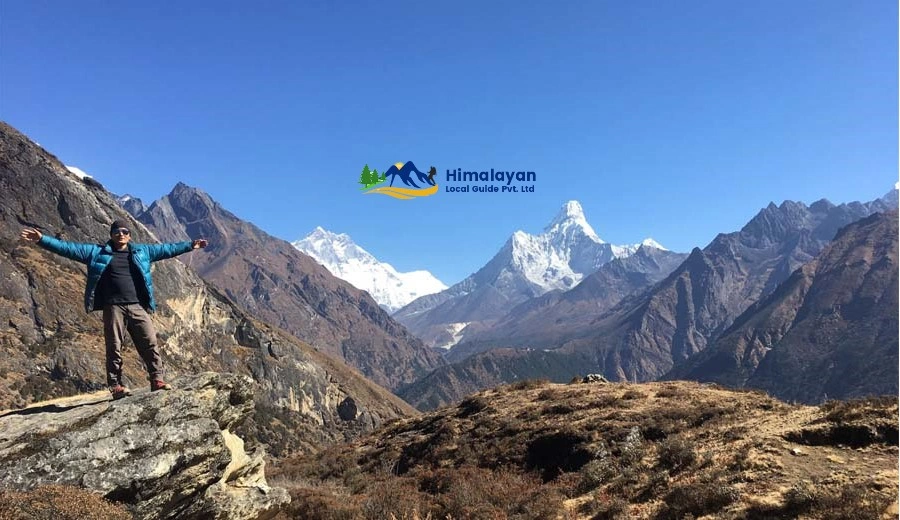

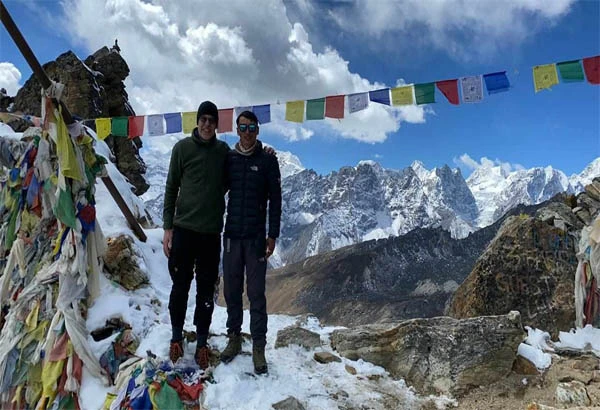
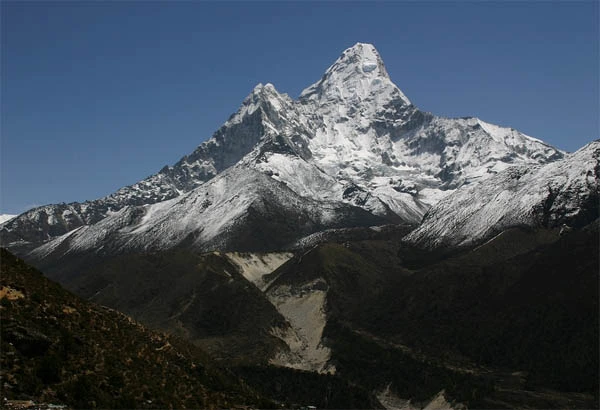

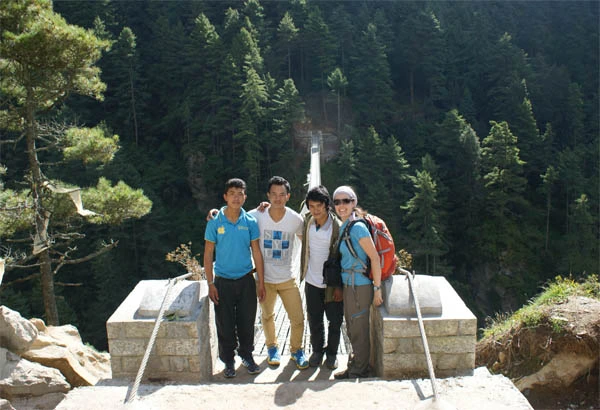
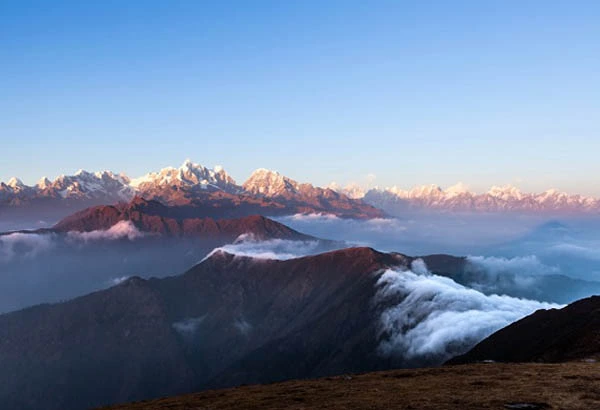

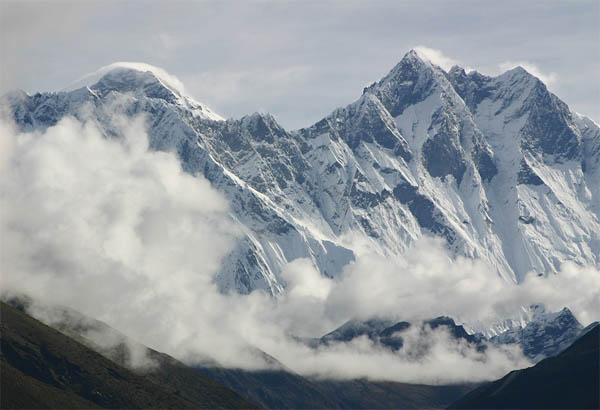
.webp)
